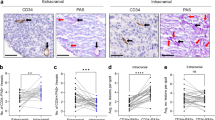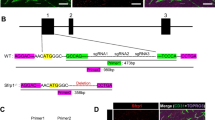Abstract
Purpose
Vasculogenic mimicry (VM), a vessel-like network formed by highly aggressive tumor cells, plays an important role in accelerating cancer progression. This special vascularization pattern is closely associated with a poor prognosis in various cancers. As yet, however, the regulatory mechanism of VM formation is largely unknown. In this study, we assess whether the long noncoding RNA PVT1 is involved in VM generation in gastric cancer.
Methods
VM formation was determined by immunohistochemistry using PAS/CD31 double staining in gastric cancers and Matrigel tube formation in vitro. qRT-PCR and Western blotting were used to assess mRNA and protein expression. Interaction between PVT1 and STAT3 was determined using a RNA pull-down assay. Luciferase reporter and chromatin immunoprecipitation assays were performed to evaluate transcriptional activity of STAT3 on the Slug gene promoter.
Results
We found that PVT1 can induce VM generation both in vitro and in vivo. Mechanistically, we found that PVT1 interacted with and activated STAT3 through a 850–1770 nt fragment. PVT1 facilitated STAT3 recruitment to the Slug promoter and transcriptionally enhanced Slug expression, thereby triggering epithelial-to-mesenchymal transition (EMT) and VM capillary formation. STAT3 inhibition effectively blocked PVT1-mediated VM. In primary gastric cancer samples, a positive correlation was found between PVT1 and Slug upregulation, and patients with a high PVT1 and Slug expression exhibited markedly shorter survival times.
Conclusion
Our results shed light on the role of PVT1 in gastric cancer cell-dependent VM formation. Our findings provide valuable clues for the design of new anti-angiogenic therapeutic strategies. The PVT1/STAT3 axis may serve as a potential target in gastric cancer treatment.






Similar content being viewed by others
References
F. Bray, J. Ferlay, I. Soerjomataram, R.L. Siegel, L.A. Torre, A. Jemal, Global cancer statistics 2018: GLOBOCAN estimates of incidence and mortality worldwide for 36 cancers in 185 countries. CA Cancer J Clin 68, 394–424 (2018)
A. Ferro, B. Peleteiro, M. Malvezzi, C. Bosetti, P. Bertuccio, F. Levi, E. Negri, C. La Vecchia, N. Lunet, Worldwide trends in gastric cancer mortality (1980-2011), with predictions to 2015, and incidence by subtype. Eur J Cancer 50, 1330–1344 (2014)
C.S. Fuchs, J. Tomasek, C.J. Yong, F. Dumitru, R. Passalacqua, C. Goswami, H. Safran, L.V.D. Santos, G. Aprile, D.R. Ferry, B. Melichar, M. Tehfe, E. Topuzov, J.R. Zalcberg, I. Chau, W. Campbell, C. Sivanandan, J. Pikiel, M. Koshiji, Y. Hsu, A.M. Liepa, L. Gao, J.D. Schwartz, J. Tabernero, R.T. Investigators, Ramucirumab monotherapy for previously treated advanced gastric or gastro-oesophageal junction adenocarcinoma (REGARD): an international, randomised, multicentre, placebo-controlled, phase 3 trial. Lancet 383, 31–39 (2014)
M. Paez-Ribes, E. Allen, J. Hudock, T. Takeda, H. Okuyama, F. Vinals, M. Inoue, G. Bergers, D. Hanahan, O. Casanovas, Antiangiogenic therapy elicits malignant progression of tumors to increased local invasion and distant metastasis. Cancer Cell 15, 220–231 (2009)
M.J. Hendrix, E.A. Seftor, A.R. Hess, R.E. Seftor, Vasculogenic mimicry and tumour-cell plasticity: Lessons from melanoma. Nature Rev Cancer 3, 411–421 (2003)
Y.W. Paulis, P.M. Soetekouw, H.M. Verheul, V.C. Tjan-Heijnen, A.W. Griffioen, Signalling pathways in vasculogenic mimicry. Biochim Biophys Acta 1806, 18–28 (2010)
H.S. Kim, Y.J. Won, J.H. Shim, H.J. Kim, J. Kim, H.N. Hong, B.S. Kim, Morphological characteristics of vasculogenic mimicry and its correlation with EphA2 expression in gastric adenocarcinoma. Sci Rep 9, 3414 (2019)
J. Sun, B. Sun, R. Sun, D. Zhu, X. Zhao, Y. Zhang, X. Dong, N. Che, J. Li, F. Liu, N. Zhao, Y. Wang, D. Zhang, HMGA2 promotes vasculogenic mimicry and tumor aggressiveness by upregulating Twist1 in gastric carcinoma. Sci Rep 7, 2229 (2017)
M. Huarte, The emerging role of lncRNAs in cancer. Nature Med 21, 1253–1261 (2015)
R. Castro-Oropeza, J. Melendez-Zajgla, V. Maldonado, K. Vazquez-Santillan, The emerging role of lncRNAs in the regulation of cancer stem cells. Cell Oncol 41, 585–603 (2018)
L. Wei, X. Wang, L. Lv, Y. Zheng, N. Zhang, M. Yang, The emerging role of noncoding RNAs in colorectal cancer chemoresistance. Cell Oncol 42, 757–768 (2019)
Y.Y. Tseng, B.S. Moriarity, W. Gong, R. Akiyama, A. Tiwari, H. Kawakami, P. Ronning, B. Reuland, K. Guenther, T.C. Beadnell, J. Essig, G.M. Otto, M.G. O'Sullivan, D.A. Largaespada, K.L. Schwertfeger, Y. Marahrens, Y. Kawakami, A. Bagchi, PVT1 dependence in cancer with MYC copy-number increase. Nature 512, 82–86 (2014)
T. Colombo, L. Farina, G. Macino, P. Paci, PVT1: A rising star among oncogenic long noncoding RNAs. Biomed Res Int 2015, 304208 (2015)
S.N. Shen, K. Li, Y. Liu, C.L. Yang, C.Y. He, H.R. Wang, Down-regulation of long noncoding RNA PVT1 inhibits esophageal carcinoma cell migration and invasion and promotes cell apoptosis via microRNA-145-mediated inhibition of FSCN1. Mol Oncol 13, 2554–2573 (2019)
J. Zhao, P. Du, P. Cui, Y. Qin, C. Hu, J. Wu, Z. Zhou, W. Zhang, L. Qin, G. Huang, LncRNA PVT1 promotes angiogenesis via activating the STAT3/VEGFA axis in gastric cancer. Oncogene 37, 4094–4109 (2018)
A.J. Maniotis, R. Folberg, A. Hess, E.A. Seftor, L.M. Gardner, J. Pe'er, J.M. Trent, P.S. Meltzer, M.J. Hendrix, Vascular channel formation by human melanoma cells in vivo and in vitro: Vasculogenic mimicry. Am J Pathol 155, 739–752 (1999)
D. Delgado-Bellido, S. Serrano-Saenz, M. Fernandez-Cortes, F.J. Oliver, Vasculogenic mimicry signaling revisited: Focus on non-vascular VE-cadherin. Mol Cancer 16, 65 (2017)
T. Sun, N. Zhao, X.L. Zhao, Q. Gu, S.W. Zhang, N. Che, X.H. Wang, J. Du, Y.X. Liu, B.C. Sun, Expression and functional significance of Twist1 in hepatocellular carcinoma: Its role in vasculogenic mimicry. Hepatology 51, 545–556 (2010)
D. Sun, B. Sun, T. Liu, X. Zhao, N. Che, Q. Gu, X. Dong, Z. Yao, R. Li, J. Li, J. Chi, R. Sun, Slug promoted vasculogenic mimicry in hepatocellular carcinoma. J Cell Mol Med 17, 1038–1047 (2013)
C.J. Shen, Y.M. Cheng, C.L. Wang, LncRNA PVT1 epigenetically silences miR-195 and modulates EMT and chemoresistance in cervical cancer cells. J Drug Target 25, 637–644 (2017)
X. Zhang, W. Feng, J. Zhang, L. Ge, Y. Zhang, X. Jiang, W. Peng, D. Wang, A. Gong, M. Xu, Long noncoding RNA PVT1 promotes epithelialmesenchymal transition via the TGFbeta/Smad pathway in pancreatic cancer cells. Oncol Rep 40, 1093–1102 (2018)
D. Hanahan, R.A. Weinberg, Hallmarks of cancer: The next generation. Cell 144, 646–674 (2011)
S. Zhang, D. Zhang, B. Sun, Vasculogenic mimicry: Current status and future prospects. Cancer Lett 254, 157–164 (2007)
X. Li, Y. Xue, X. Liu, J. Zheng, S. Shen, C. Yang, J. Chen, Z. Li, L. Liu, J. Ma, T. Ma, Y. Liu, ZRANB2/SNHG20/FOXK1 axis regulates vasculogenic mimicry formation in glioma. J Exp Clin Cancer Res 38, 68 (2019)
Y. Xia, X.Y. Cai, J.Q. Fan, L.L. Zhang, J.H. Ren, Z.Y. Li, R.G. Zhang, F. Zhu, G. Wu, The role of sema4D in vasculogenic mimicry formation in non-small cell lung cancer and the underlying mechanisms. Int J Cancer 144, 2227–2238 (2019)
S. Liu, C. Ni, D. Zhang, H. Sun, X. Dong, N. Che, X. Liang, C. Chen, F. Liu, J. Bai, X. Lin, X. Zhao, B. Sun, S1PR1 regulates the switch of two angiogenic modes by VE-cadherin phosphorylation in breast cancer. Cell Death Dis 10, 200 (2019)
J. Guo, H. Cai, X. Liu, J. Zheng, Y. Liu, W. Gong, J. Chen, Z. Xi, Y. Xue, Long non-coding RNA LINC00339 stimulates glioma vasculogenic mimicry formation by regulating the miR-539-5p/TWIST1/MMPs axis. Mol Ther Nucl Acids 10, 170–186 (2018)
W. Yu, J. Ding, M. He, Y. Chen, R. Wang, Z. Han, E.Z. Xing, C. Zhang, S. Yeh, Estrogen receptor beta promotes the vasculogenic mimicry (VM) and cell invasion via altering the lncRNA-MALAT1/miR-145-5p/NEDD9 signals in lung cancer. Oncogene 38, 1225–1238 (2019)
Y. Li, Z. Wu, J. Yuan, L. Sun, L. Lin, N. Huang, J. Bin, Y. Liao, W. Liao, Long non-coding RNA MALAT1 promotes gastric cancer tumorigenicity and metastasis by regulating vasculogenic mimicry and angiogenesis. Cancer Lett 395, 31–44 (2017)
B. Sun, D. Zhang, N. Zhao, X. Zhao, Epithelial-to-endothelial transition and cancer stem cells: Two cornerstones of vasculogenic mimicry in malignant tumors. Oncotarget 8, 30502–30510 (2017)
W. Lu, Y. Kang, Epithelial-mesenchymal plasticity in cancer progression and metastasis. Dev Cell 49, 361–374 (2019)
S.M. Weis, D.A. Cheresh, Tumor angiogenesis: Molecular pathways and therapeutic targets. Nature Med 17, 1359–1370 (2011)
M.L. Pecero, J. Salvador-Bofill, S. Molina-Pinelo, Long non-coding RNAs as monitoring tools and therapeutic targets in breast cancer. Cell Oncol 42, 1–12 (2019)
Acknowledgments
This study was supported by the Natural Science Foundation of China (81672378 and 81201521).
Author information
Authors and Affiliations
Contributions
Lunxiu Qin, Guangjian Huang and Wenhong Zhang designed the study. Material preparation, experiment operation and data analysis were mainly performed by Jing Zhao, Jing Wu and Qin Yunyun. The first draft of the manuscript was written by Jing Zhao, Wenhong Zhang Guangjian Huang and Lunxiu Qin. All authors commented on previous versions of the manuscript and approved the final manuscript.
Corresponding authors
Ethics declarations
Each of the enrolled patients has provided written informed consent. The study protocol was approved by the Human Research Ethics Committee of Huashan Hospital of Fudan University. The animal experiments were approved by the Institutional Animal Care and Use Committee at Huashan Hospital of Fudan University, and performed in line with the USA NIH laboratory animal care and usage guidelines.
Conflict of interest
The authors declare no conflict of interest.
Additional information
Publisher’s note
Springer Nature remains neutral with regard to jurisdictional claims in published maps and institutional affiliations.
Rights and permissions
About this article
Cite this article
Zhao, J., Wu, J., Qin, Y. et al. LncRNA PVT1 induces aggressive vasculogenic mimicry formation through activating the STAT3/Slug axis and epithelial-to-mesenchymal transition in gastric cancer. Cell Oncol. 43, 863–876 (2020). https://doi.org/10.1007/s13402-020-00532-6
Accepted:
Published:
Issue Date:
DOI: https://doi.org/10.1007/s13402-020-00532-6




